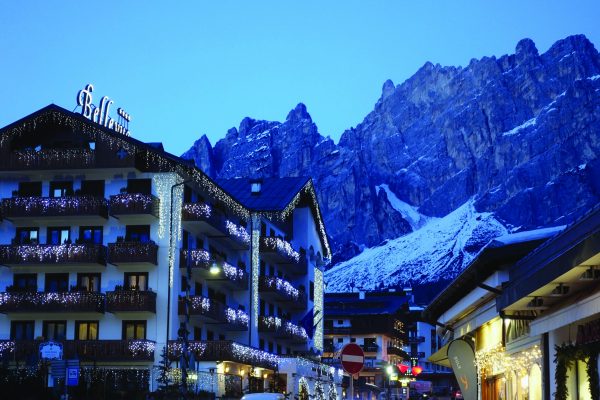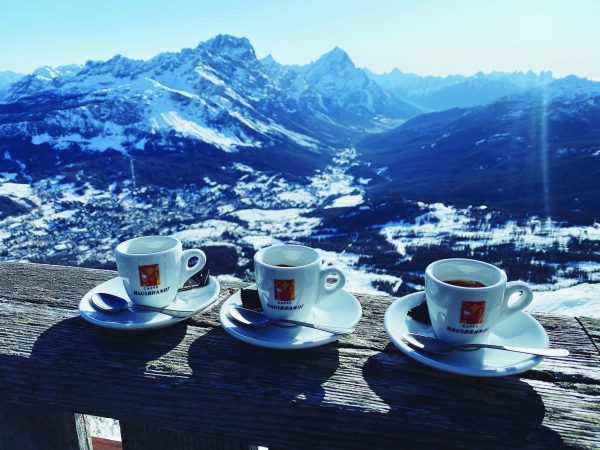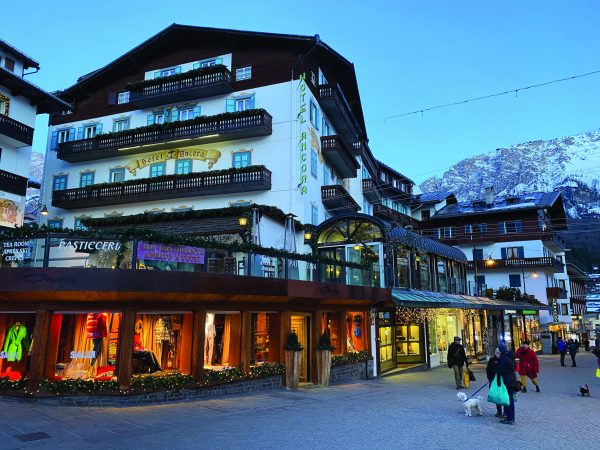Cortina d’Ampezzo exudes Italian elegance and style. Alongside its glorious pistes there is shopping, strolling and a cultured après-ski. Mary Novakovich reports on a visit she made there…
Images by Adam Batterbee
Cortina d’Ampezzo’s elegance is practically inexhaustible. Fashions come and go, but this grande dame of Europe’s great ski resorts still reigns as the queen of the Dolomites. Like its French and Swiss counterparts, Megève and St Moritz, Cortina exudes old-school glamour and attracts people more interested in shopping and strolling than actually skiing. But for those of us who do enjoy skiing as much as these other activities that means blissfully empty slopes – and in a setting that is, quite simply, spectacular.
The Dolomites are astonishing, their jagged coral peaks looking distinctly otherworldly against the white snow and vivid blue skies. Their shapes – as if someone had come along with a giant cleaver and hacked away willy-nilly – are unlike anything else you would find in the Alps, and the giddiness they inspire makes skiing here utterly magical.
Après-Ski
Cortina is probably the most Italian of the Dolomiti Superski resorts, being in the Veneto region rather than the partly German-speaking Südtirol region. You certainly get that sense on Corso Italia, the pedestrian heart of the town. Cortina doesn’t do après-ski like its Austrian neighbours. You won’t find raucous singing to cheesy pop songs, even if there are a couple of German-style bars selling beer and wurst. What you will find – at that period of the afternoon when the sun is low and Corso Italia becomes a twinkling lane of fairy lights – is the passeggiata, some people still in their ski gear, many others already dressed smartly for the evening ahead.
Tempted by the Embassy Bar Café, where the aperitivo snacks were being prepared for later glasses of prosecco, I indulged in a hot chocolate that was as thick as treacle but, gratifyingly, nowhere near as sweet. It enhanced the fuzzy feeling of well-being I had been enjoying all day – a day spent on Cortina’s superb slopes. (I was lucky enough to visit just before Covid-19 changed the world, and I was able to see Cortina at its most ravishing.)
Ski school
That morning, I met Francesco from M’Over, the ski school run by the World Cup ski racer and Cortina native Kristian Ghedina. A quick shuttle bus ride took us past the Olympic Ice Stadium – Cortina hosted the 1956 Winter Olympics and will join Milan in hosting the Games in 2026 – to one of Cortina’s main ski areas, Tofana.
Encompassing the Socrepes and Pocol areas, Tofana had pretty much everything this average intermediate skier could hope for. (Another ski area, Faloria, at the southern end of the town, is more suited to confident intermediates and experts.) At Tofana, in keeping with Cortina’s relaxed pace of life, there were plenty of wide cruising runs that wound through woods and then opened up at the foot of another awe-inducing Dolomite peak. A few red runs added spice to the easy-going atmosphere, and I could see where pistes were being prepared for the 2021 World Ski Championships. Francesco pointed out the Forcella Rossa black run, a piste so infamously steep that its devotees have created their own club, the All Blacks, for anyone who manages to ski it 100 times over a ski season. Evidently not a club I’ll be joining.
The Tofana gondola took me up to Capanna Ra Valles – “the highest pizzeria in Europe”, as it describes itself. It certainly offered one of the most captivating views of the Dolomites and the Ampezzo Valley from its circular terrace at 2,470 metres. But I was saving myself for lunch back at the bottom of the Socrepes chairlift, on the sunny terrace of Chalet Tofane. I was already developing an addiction to a local dish from the Ampezzo Valley: spinach spätzle with speck and gorgonzola. As with another popular Cortinese dish, casunziei – ravioli with beetroot and poppy seeds – you can taste hints of the Austro-Hungarian Empire, which ruled here for over 400 years.
The Super 8
Tofana whetted my appetite for the following day’s adventure: skiing the Super 8 route that curves along in the shape of an eight (naturally). It’s sheer drama all the way, starting with the startling beauty of the Cinque Torri, five mis-shapen towers that are among the rock stars of the Dolomites. If I’d had the time, I could have stopped for a wallow in the outdoor hot tub that’s at the foot of the mountains, but I wanted to crack on with the 16km circuit through this enormous UNESCO World Heritage Site.
After a series of more impossibly scenic runs, I found myself on the terrace of Rifugio Lagazuoi at 2,750 metres. I wasn’t particularly tempted by the highest outdoor sauna in the Dolomites on the huge terrace of the restaurant, but I did spot a sign saying “To the tunnel”. Parts of the Super 8 overlap with the Great War Ski Tour, an 80km circuit that takes you past the sites of some of the most terrible battles of the First World War.
It was here that the Central Powers’ Austro-Hungarian forces – whose ranks included the Cortinesi – fought the Italian Alpini in vertical battles that were exceptionally brutal in their intensity. The tunnel sign referred to one of the gun emplacements that was dug into solid rock, which you could ski directly to.
I swiftly added the whole Great War Ski Tour to my list of things to do the next time I’m in the Dolomites. In the meantime, I had a date with a horse… Once I skied down the tricky red run from Lagazuoi, I joined a convoy of skiers being pulled along by horses towards the neighbouring resort of Alta Badia. And to complete the Super 8 circuit, a shuttle bus took me to Passo Falzarego, where I could ski back to the foot of the Cinque Torri. A much-needed lunch was a platter of speck and local cheeses followed by a big plate of tagliolini smothered in a rich porcini sauce at the nicely rustic Baita Bai de Dones.
Contemporary Art
Back in Corso Italia, before I could be seduced by another hot chocolate at the Embassy, I popped into the Modern Art Museum, which turned out to have some fascinating contemporary artworks amassed by the late Cortinese art collector Mario Rimoldi. I also discovered that, for all Cortina’s reputation for ultrachic shopping (including the usual suspects Dior and Valentino), there’s a very stylish affordable option. The sprawling Cooperativa department store is really rather wonderful, filled with everything from food and drink to clothing, hiking wear, haberdashery and homeware.
It is hard not to fall in love with Cortina. I was bewitched by its class, cuisine, culture and beauty – on and off the slopes. Who knows when it will be, but on my return I will take that Great War Ski Tour.
Liked this article? Take a look at the Italia! Dolomites archive today…



